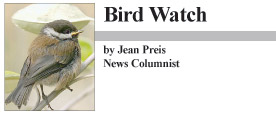Common redpolls
In the early morning, we like to sit in front of the living room window with a cup of tea and watch the day begin. In the depth of winter, we look at stars twinkling overhead in a dark sky, and then see the first light of dawn. Before the sun comes over the hill, we watch chickadees emerge from the shelter of thick shrubs in the backyard and fly around the corner of the house on their way to the feeders. All winter these hardy little birds have come to our feeders, along with a few nuthatches and woodpeckers, and a mob of goldfinches. While we never tire of seeing them, occasionally we have found ourselves wishing for something new to look at, so when we started hearing about large flocks of common redpolls at friends’ feeders we found ourselves wondering if redpolls might come to our yard, too.
twinkling overhead in a dark sky, and then see the first light of dawn. Before the sun comes over the hill, we watch chickadees emerge from the shelter of thick shrubs in the backyard and fly around the corner of the house on their way to the feeders. All winter these hardy little birds have come to our feeders, along with a few nuthatches and woodpeckers, and a mob of goldfinches. While we never tire of seeing them, occasionally we have found ourselves wishing for something new to look at, so when we started hearing about large flocks of common redpolls at friends’ feeders we found ourselves wondering if redpolls might come to our yard, too.
This morning, I am eating my breakfast, watching birds eat their breakfast. The day looks promising with a clear pale blue sky, and I am happy because I am looking at dozens of redpolls. Several times a day they drift down from the sky, to perch in the big maple tree before fluttering down onto the snow. Earlier in the winter, I had been reluctant to toss bird seed onto the soft snow because the seeds sank in and were wasted, but lately the snow has hardened up, and the handfuls of seeds I threw out this morning bounced on the hard crust and scattered noisily across the snow-covered dooryard. It took almost no time for the redpolls to discover this new source of food.
Common redpolls are about the same size as goldfinches, and when dozens and dozens of birds are scurrying around on the snow it is easy to just quickly glance out the window and think they are all goldfinches. If I stop for a closer look, though, I see how different they really are. The redpolls are chunky little birds, heavily streaked with dark brown, with a dark red cap that tips down low over the forehead and a patch of black under the chin. The streaks come down the side of the breast but do not quite meet in the middle. On males, the upper breast is a warm rosy color, on females it is whitish.
Redpolls are members of the finch family who live and breed on the tundra of Alaska, northern Canada, Greenland, and around the world at the top of the globe, where winter is long and cold and daylight is in short supply. They are seedeaters, and in their native habitat they knock seeds from birch, alder, and willow catkins, and from other seed bearing plants, then pick the seeds up from where they have fallen on the ground. They live where there are limited hours of daylight for obtaining food, and where they must be careful to reduce their exposure to harsh cold weather. To survive, redpolls have developed a special bi-lobed pocket, called an esophageal diverticulum, midway down their neck. They quickly swallow as many seeds as possible, store them in this pouch, and then retreat to a sheltered spot where they can fluff up their feathers to stay warm and digest the seeds at their leisure. In some years, when the northern seed crop is in short supply, they survive by moving south to find food.
This morning, our seed feeders are crowded with goldfinches and redpolls. The goldfinches try to monopolize the perches, taking their time sorting through the seeds before selecting one to eat, but the redpolls are not shy about pushing their goldfinch cousins out of the way to get their share. It is a treat to see redpolls, but with the arrival of spring they will return to the far north. One day when we look outside they will not be there, and it may be a long time before we get to see redpolls again.

